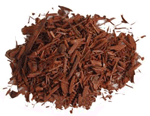
Yohimbe
Introduction
This fact sheet provides basic information about the herb plant or part of a plant used for its flavor, scent, or potential therapeutic properties. Includes flowers, leaves, bark, fruit, seeds, stems, and roots. yohimbe-common names, uses, potential side effects, and resources for more information. The yohimbe tree is a tall evergreen that is native to western Africa. The bark of the tree contains a chemical called yohimbine. The amount of yohimbine in dietary supplements may vary; some yohimbe products have been found to contain very little yohimbine. However, a standardized form of yohimbine-yohimbine hydrochloride-is available as a prescription medicine that has been studied and used for the treatment of erectile dysfunction.
Common Names
yohimbe, yohimbe bark
Latin Names
Pausinystalia yohimbe
What It Is Used For
- Yohimbe bark has traditionally been used in Africa as an aphrodisiac (to increase sexual desire).
- The herb is currently used for sexual dysfunction, including erectile dysfunction in men.
How It Is Used
As a dietary supplement product that contains vitamins, minerals, herbs or other botanicals, amino acids, enzymes, and/or other ingredients intended to supplement the diet. The U.S. Food and Drug Administration has special labeling requirements for dietary supplements., the dried bark of the yohimbe tree is used as a tea and taken by mouth. An extract of the bark is also put into capsules and tablets.
What the Science Says
- It is not known whether yohimbe is effective for any health conditions because clinical trials have not been conducted on the bark or its extract.*
* Although numerous studies of the prescription medicine yohimbine hydrochloride have been conducted, their results cannot be interpreted as evidence for the dietary supplement yohimbe.
Side Effects and Cautions
- Yohimbe has been associated with high blood pressure, increased heart rate, headache, anxiety, dizziness, and sleeplessness. Yohimbe can be dangerous if taken in large doses or for long periods of time.
- People should use caution if taking yohimbe with MAO inhibitors or medicines for high blood pressure. Yohimbe should not be combined with tricyclic antidepressants or phenothiazines (a group of medicines used mostly for mental health conditions such as schizophrenia).
- People with kidney problems and people with psychiatric conditions should not use yohimbe.
- Tell your health care providers about any complementary and alternative practices you use. Give them a full picture of what you do to manage your health. This will help ensure coordinated and safe care.
Sources
- Yohimbe bark extract. Natural Standard Database Web site. Accessed on February 5, 2007.
- Yohimbe. Natural Medicines Comprehensive Database Web site. Accessed on February 5, 2007.
- Yohimbe bark. In: Blumenthal M, Goldberg A, Brinckman J, eds. Herbal Medicine: Expanded Commission E Monographs. Newton, MA: Lippincott Williams & Wilkins; 2000:429-431.
- NCCAM National Institutes of Health







